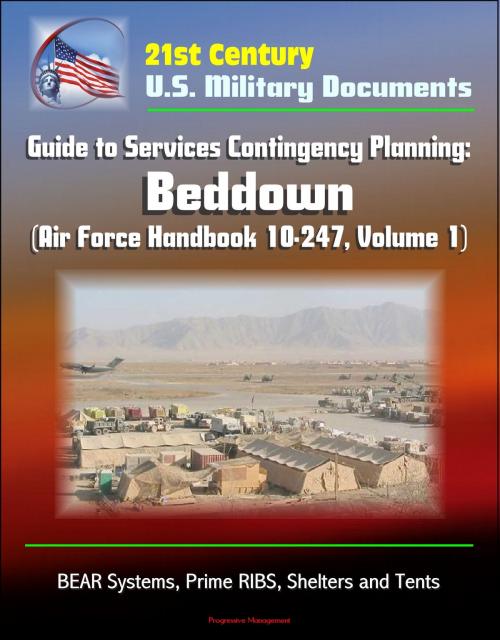21st Century U.S. Military Documents: Guide to Services Contingency Planning: Beddown (Air Force Handbook 10-247, Volume 1) - BEAR Systems, Prime RIBS, Shelters and Tents
Nonfiction, History, Military, Aviation| Author: | Progressive Management | ISBN: | 9781301758951 |
| Publisher: | Progressive Management | Publication: | October 11, 2013 |
| Imprint: | Smashwords Edition | Language: | English |
| Author: | Progressive Management |
| ISBN: | 9781301758951 |
| Publisher: | Progressive Management |
| Publication: | October 11, 2013 |
| Imprint: | Smashwords Edition |
| Language: | English |
This guide provides planners with an overview of the beddown assets, tasks, and basic procedures required for Air and Space Expeditionary Force (AEF) bare base operations. It introduces the AEF concept of using Force Modules for planning AEF deployments. While each deployment location has its special requirements, there are common, basic approaches for providing services at all locations. You will have to use and adapt the layouts and procedures to meet your location. Other branches of the Armed Forces' Services and Morale, Welfare, and Recreation organizations may approach support for Joint Service beddowns differently, but the basic requirements are similar and will be addressed as they apply to AEF bare base and austere bare base deployments and the use of Force Modules.
Services can trace some of their history back to the American Revolution and the Army's Quartermaster Department, which was responsible for camp equipment, tents, transportation, and winter quarters using wood stores for heat. Congress added subsistence to the Quartermaster's responsibilities by the War of 1812, because while the Commissary Department could buy food, often they could not get the rations to the troops. Prior to the 1846 Mexican War, the Quartermaster Department picked up responsibility for clothing and other field equipment. Laundry support services did not exist through the Civil and Spanish American Wars. Soldiers wore their uniforms until they fell apart and were replaced, or washed themselves and their clothes in whatever water was available.
Section A * INTRODUCTION * 1. Purpose * 2. Background * 3. Primary Sources * Section B * AEF DEPLOYMENTS USING FORCE MODULES * 4. Deployment Requirements Change * 5. Deployment Planning Changes * 6. AEF Mission Planning Restrictions/Considerations and the Force Module Concept * 7. Force Modules and BEAR Sets * SECTION C * DEPLOYMENT PLANNING AND USE OF FORCE MODULES * 8. Predeployment Planning Phase * 9. General Services Planning Actions and Factors * Section D * MAJOR SYSTEM COMPONENTS * 10. Background * 11. Contingency Lodging * 12. Food Service * 13. Hygiene Facilities * 14. Field Mortuary Operations * 15. Laundry * 16. Expedient Support * 17. First-In Deployable Support System * 18. Fitness, Recreation, and Item Sales * Section E * ON-SITE DEPLOYMENT PLANNING * 19. On-Site Planning * 20. Layout Concept * 21. Lodging Community Layout * 22. Food Service Layout and Requirements * 23. Laundry Support * 24. Mortuary Affairs * 25. Quality of Life * Section F * BEDDOWN TASKS * 26. Purpose of this Section * 27. Question Yourself Upon Arrival * 28. Tasks by Major Areas of Services Function
This guide provides planners with an overview of the beddown assets, tasks, and basic procedures required for Air and Space Expeditionary Force (AEF) bare base operations. It introduces the AEF concept of using Force Modules for planning AEF deployments. While each deployment location has its special requirements, there are common, basic approaches for providing services at all locations. You will have to use and adapt the layouts and procedures to meet your location. Other branches of the Armed Forces' Services and Morale, Welfare, and Recreation organizations may approach support for Joint Service beddowns differently, but the basic requirements are similar and will be addressed as they apply to AEF bare base and austere bare base deployments and the use of Force Modules.
Services can trace some of their history back to the American Revolution and the Army's Quartermaster Department, which was responsible for camp equipment, tents, transportation, and winter quarters using wood stores for heat. Congress added subsistence to the Quartermaster's responsibilities by the War of 1812, because while the Commissary Department could buy food, often they could not get the rations to the troops. Prior to the 1846 Mexican War, the Quartermaster Department picked up responsibility for clothing and other field equipment. Laundry support services did not exist through the Civil and Spanish American Wars. Soldiers wore their uniforms until they fell apart and were replaced, or washed themselves and their clothes in whatever water was available.
Section A * INTRODUCTION * 1. Purpose * 2. Background * 3. Primary Sources * Section B * AEF DEPLOYMENTS USING FORCE MODULES * 4. Deployment Requirements Change * 5. Deployment Planning Changes * 6. AEF Mission Planning Restrictions/Considerations and the Force Module Concept * 7. Force Modules and BEAR Sets * SECTION C * DEPLOYMENT PLANNING AND USE OF FORCE MODULES * 8. Predeployment Planning Phase * 9. General Services Planning Actions and Factors * Section D * MAJOR SYSTEM COMPONENTS * 10. Background * 11. Contingency Lodging * 12. Food Service * 13. Hygiene Facilities * 14. Field Mortuary Operations * 15. Laundry * 16. Expedient Support * 17. First-In Deployable Support System * 18. Fitness, Recreation, and Item Sales * Section E * ON-SITE DEPLOYMENT PLANNING * 19. On-Site Planning * 20. Layout Concept * 21. Lodging Community Layout * 22. Food Service Layout and Requirements * 23. Laundry Support * 24. Mortuary Affairs * 25. Quality of Life * Section F * BEDDOWN TASKS * 26. Purpose of this Section * 27. Question Yourself Upon Arrival * 28. Tasks by Major Areas of Services Function















